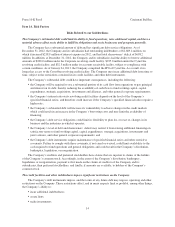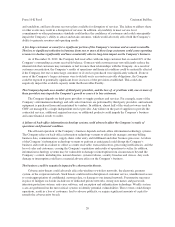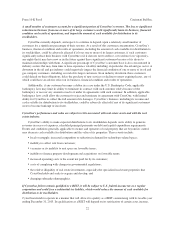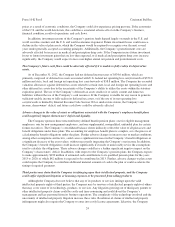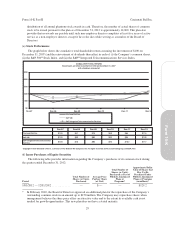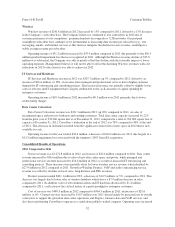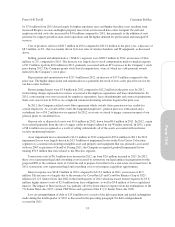Cincinnati Bell 2012 Annual Report Download - page 98
Download and view the complete annual report
Please find page 98 of the 2012 Cincinnati Bell annual report below. You can navigate through the pages in the report by either clicking on the pages listed below, or by using the keyword search tool below to find specific information within the annual report.prices as a result of economic conditions, the Company could also experience pricing pressure. If the economies
of the U.S. and the world deteriorate, this could have a material adverse effect on the Company’s business,
financial condition, results of operations, and cash flows.
In addition, investment returns of the Company’s pension funds depend largely on trends in the U.S. and
world securities markets and the U.S. and world economies in general. Future investment losses could cause a
decline in the value of plan assets, which the Company would be required to recognize over the next several
years under generally accepted accounting principles. Additionally, the Company’s postretirement costs are
adversely affected by increases in medical and prescription drug costs. If the Company incurs future investment
losses or future investment gains that are less than expected, or if medical and prescription drug costs increase
significantly, the Company would expect to face even higher annual net pension and postretirement costs.
The Company’s future cash flows could be adversely affected if it is unable to fully realize its deferred tax
assets.
As of December 31, 2012, the Company had net deferred income taxes of $434.6 million, which are
primarily composed of deferred tax assets associated with U.S. federal net operating loss carryforwards of $352.0
million and state, local and foreign net operating loss carryforwards of $58.8 million. The Company has recorded
valuation allowances against deferred tax assets related to certain state, local and foreign net operating losses and
other deferred tax assets due to the uncertainty of the Company’s ability to utilize the assets within the statutory
expiration period. The use of the Company’s deferred tax assets enables it to satisfy current and future tax
liabilities without the use of the Company’s cash resources. If the Company is unable for any reason to generate
sufficient taxable income to fully realize its deferred tax assets, or if the use of its net operating loss
carryforwards is limited by Internal Revenue Code Section 382 or similar state statute, the Company’s net
income, shareowners’ deficit, and future cash flows could be adversely affected.
Adverse changes in the value of assets or obligations associated with the Company’s employee benefit plans
could negatively impact shareowners’ deficit and liquidity.
The Company sponsors three noncontributory defined benefit pension plans: one for eligible management
employees, one for non-management employees, and one supplemental, nonqualified, unfunded plan for certain
former executives. The Company’s consolidated balance sheets indirectly reflect the value of all plan assets and
benefit obligations under these plans. The accounting for employee benefit plans is complex, as is the process of
calculating the benefit obligations under the plans. Further adverse changes in interest rates or market conditions,
among other assumptions and factors, could cause a significant increase in the Company’s benefit obligations or
a significant decrease of the asset values, without necessarily impacting the Company’s net income. In addition,
the Company’s benefit obligations could increase significantly if it needs to unfavorably revise the assumptions
used to calculate the obligations. These adverse changes could have a further significant negative impact on the
Company’s shareowners’ deficit. In addition, with respect to the Company’s pension plans, the Company expects
to make approximately $190 million of estimated cash contributions to its qualified pension plans for the years
2013 to 2020, of which $42 million is expected to be contributed in 2013. Further, adverse changes to plan assets
could require the Company to contribute additional material amounts of cash to the plan or could accelerate the
timing of required payments.
Third parties may claim that the Company is infringing upon their intellectual property, and the Company
could suffer significant litigation or licensing expenses or be prevented from selling products.
Although the Company does not believe that any of its products or services infringe upon the valid
intellectual property rights of third parties, the Company may be unaware of intellectual property rights of others
that may cover some of its technology, products, or services. Any litigation growing out of third-party patents or
other intellectual property claims could be costly and time-consuming and could divert the Company’s
management and key personnel from its business operations. The complexity of the technology involved and the
uncertainty of intellectual property litigation increase these risks. Resolution of claims of intellectual property
infringement might also require the Company to enter into costly license agreements. Likewise, the Company
24
Form 10-K Part I Cincinnati Bell Inc.


